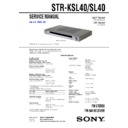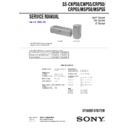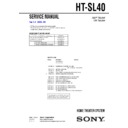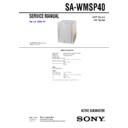Sony HT-SL40 / STR-KSL40 / STR-SL40 Service Manual ▷ View online
STR-KSL40/SL40
4
SECTION 2
TEST MODE
FACTORY PRESET MODE
* All preset contents are reset to the default setting.
* Procedure:
* Procedure:
While depressing the PLII and the PRESET TUNING + but-
tons simultaneously, press the power ?/1 button to turn on the
main power. The message “FACTORY” appears and the present
contents are reset to the default values.
tons simultaneously, press the power ?/1 button to turn on the
main power. The message “FACTORY” appears and the present
contents are reset to the default values.
RDS AUTOBETICAL MODE
* This mode is installed in the Europe models only. When this
mode is used, the receiver scans the broadcasts that can be re-
ceived by the tuner, and sets up the broadcasts. Be sure to start
scanning after connecting the antenna.
ceived by the tuner, and sets up the broadcasts. Be sure to start
scanning after connecting the antenna.
* Procedure :
1. Check that the antenna is connected.
2. While depressing the INPUT SELECTOR button, press the
1. Check that the antenna is connected.
2. While depressing the INPUT SELECTOR button, press the
?/1 button to turn on the main power.
3. The message “AUTO-BETICAL SELECT” appears and the
receiver starts scanning.
MICRO/NORMAL SPEAKER SELECTION MODE
* Either the micro speaker mode or normal speaker mode can be
selected.
* Procedure
While depressing the MUTING button, press the power ?/1
button to turn on the main power. Either the message “MICRO
SP.” or “NORM. SP.” appears. Select the desired mode.
button to turn on the main power. Either the message “MICRO
SP.” or “NORM. SP.” appears. Select the desired mode.
SOUND FIELD CLEAR MODE
* The preset sound field is cleared when this mode is activated.
Use this mode before returning the product to clients upon
completion of repair.
completion of repair.
* Procedure:
While depressing the SOUND FIELD button, press the power
?/1 button to turn on the main power. The message
“SF. CLR” appears and initialization is performed.
?/1 button to turn on the main power. The message
“SF. CLR” appears and initialization is performed.
ALL CLEAR MODE
* The all preset value is cleared when this mode is activated.
* Procedure :
* Procedure :
While depressing the PLII and the PRESET TUNING - buttons
simultaneously, press the power ?/1 button to turn on the main
power. The message “CLEARED” appears and clear all preset
value.
simultaneously, press the power ?/1 button to turn on the main
power. The message “CLEARED” appears and clear all preset
value.
SOFTWARE VERSION DISPLAY MODE
* The software version is displayed.
* Procedure:
* Procedure:
While depressing the SOUND FIELD and the PRESET TUN-
ING - buttons simultaneously, press the power ?/1 button to
turn on the main power. The model name, destination and the
software version are displayed.
ING - buttons simultaneously, press the power ?/1 button to
turn on the main power. The model name, destination and the
software version are displayed.
KEY CHECK MODE
* Button check
* Procedure:
* Procedure:
While depressing the MUTING and the INPUT SELECTOR
buttons simultaneously, press the power ?/1 button to turn on
the main power.
“REST 06” appears.
Every pressing of any button other than ?/1 counts down the
buttons. The buttons which are already counted once are not
counted again. When all buttons are pressed “REST 00” appears.
buttons simultaneously, press the power ?/1 button to turn on
the main power.
“REST 06” appears.
Every pressing of any button other than ?/1 counts down the
buttons. The buttons which are already counted once are not
counted again. When all buttons are pressed “REST 00” appears.
FLUORESCENT INDICATOR TUBE TEST MODE
* All fluorescent segments are tested. When this test is activated,
all segments turn on at the same time, then each segment turns
on one after another.
on one after another.
* Procedure:
While depressing the MUTING and the PRESET TUNING
- buttons simultaneously, press the power ?/1 button to turn
on the main power.
- buttons simultaneously, press the power ?/1 button to turn
on the main power.
1. All segments turn on.
VIDEO , DVD , TV/SAT and TUNER LED turn on.
2. Press the INPUT SELECTOR button, confirm display
VIDEO , and TUNER LED turn on.
3. Press the INPUT SELECTOR button, confirm display
DVD and TV/SAT LED turn on.
4. Press the INPUT SELECTOR button, all segments and LEDs
turn off.
5. Every pressing of the INPUT SELECTOR button turns on
each segment and LED one after another in the same order.
TUNER CHECK MODE
* Tuner check
* Procedure :
* Procedure :
While depressing the SOUND FIELD and the INPUT SE-
LECTOR buttons simultaneously, press the power ?/1 but-
ton to turn on the main power. “TUN CHK” appears and the
tuner checking is performed.
LECTOR buttons simultaneously, press the power ?/1 but-
ton to turn on the main power. “TUN CHK” appears and the
tuner checking is performed.
DSP TEST MODE
* DSP tests are performed.
* Procedure :
* Procedure :
There are two different methods to enter the test mode.
(1) While depressing the INPUT SELECTOR and PRESET
TUNING - buttons simultaneously, press the power ?/1
button to turn on the main power.
button to turn on the main power.
(2) When the set is turned on, by using the remote controller, press
the ENTER button three times, then press the MAIN MENU
button one time and thenpress the MUTING button one time.
button one time and thenpress the MUTING button one time.
• Select the item by pressing Cursor button (
V or v ).
• Select the function by pressing Cursor button (
B or b ).
L
SW
SL
SR
SSB
C
R
L F E
OPT COAX
RDS
MONO
ST
D.RANGE
dB
kHz
mft.
mft.
MHz
DIGITAL
PRO LOGIC II
PRO LOGIC II
DTS
MPEG-2 AAC
D D
D D
D D
MEMORY
L
SW
SR
S
C
R
L F E
COAX
RDS
MONO
ST
k
m
m
MHz
DIGITAL
PRO LOGIC
PRO LOGIC
MPEG
D D
D D
D D
SL
S B
OPT
D.RANGE
dB
Hz
ft.
II
DTS
-2 AAC
MEMORY
STR-KSL40/SL40
5
• DSP Test Mode Items
Items
SWAP
DSP Version
DSP communication
Bass Management
Main Speaker cut off Freq.
LFE cut off Freq.
Co-ef. Read Address
Co-ef. Read Data
Co-ef. Write Address
Co-ef. Write Data
SRAM
Total operation time
Longest Power ON time
Output time less than
–50dB volume
Output time less than
–40dB volume
Output time less than
–30dB volume
Output time less than
–20dB volume
Output time less than
–10dB volume
Output time less than
0dB volume
Protector count value
Fuse open count value
EEPROM CONDITION
EEPROM READ
EEPROM Super Reset
DSP HALT MODE
Remark
Selection of setting
output channels
Checking communication
between DSP and microcom
between DSP and microcom
Checking communication
between DSP and SRAM
between DSP and SRAM
Four large charactors are
hour. Two small charactors
are minutes.
0 to 255
Description
Normal channel output
Left input
t Front Left, Surround Left, Center channel output
Right input
t Front Right, Surround Right, Sub Woofer channel output
Left input
t Center channel output
Right input
t Sub Woofer channel output
Left input
t Surround Left channel output
Right input
t Surround Right channel output
“DSPV XXX” is displayed. Three large charactors are the DSP version
that is being used.
that is being used.
When this item is selected the message will be displayed “ OK ” if the
checking is correct. “ ERROR ” will be displayed in a case of an error.
checking is correct. “ ERROR ” will be displayed in a case of an error.
“SUR-NORM” is displayed.
“EQ-NORM” is displayed.
“DLY-NORM” is displayed.
“BM-NORM” is displayed.
Not used for service “BM. AUTO” is displayed.
Not used for service “MAIN 120 Hz” is displayed.
Not used for service “LFE 120 Hz” is displayed.
Not used for service “RA. XXXXX” is displayed.
Not used for service “RD. XXXXXX xx” is displayed.
Not used for service “WA. XXXXX” is displayed.
Not used for service “WD. XXXXXX xx” is displayed.
“ RAMC. OFF ” will be displayed in a case of no checking.
By pressing Cursor button the checking starts.
“ RAMC. PASS ” will be displayed if the checking is good.
“ RAMC. NG ” will be displayed if an error occurs.
“ RAMC. NG ” will be displayed if an error occurs.
“TTL-XXXX xx” is displayed.
“LNG-XXXX xx” is displayed.
“V50-XXXX xx” is displayed.
“V40-XXXX xx” is displayed.
“V30-XXXX xx” is displayed.
“V20-XXXX xx” is displayed.
“V10-XXXX xx” is displayed.
“V00-XXXX xx” is displayed.
“PROT XXX” is displayed.
“FUSE XXX” is displayed.
“E- XXXX” is displayed.
S RST
t Super Reset : first time use EEPROM or test pattern
corrupted
FAIL
t EEPROM read / write with microcom has problem
V CHG
t Software version change
D CHG
t Destination / model change
CLEAR
t Back up data initialize
NORM
t Normal AC on
“E- XXX-XX” is displayed.
First four hex code is EEPROM address (controlled by +/– button).
Last two hex code is EEPROM data.
“S.RST- XXX” is displayed.
When YES is selected, press Cursor button to clear all EEPROM data
“HALT NO” or “HALT YES” is displayed.
Function
NORM
ALL
C SW
SLSR
–
–
–
–
–
–
–
–
–
–
–
–
–
OFF
ON
–
–
–
–
–
–
–
–
–
–
–
–
–
–
6
STR-KSL40/SL40
3-1. IC Pin Function Descriptions
• IC1201 CXD9617R (AUDIO DSP) (DIGITAL BOARD)
Pin No.
1
2
3
4
5
6
7
8
9
10
11
12
13
14
15
16
17
18
19
20
21
22
23 to 25
26
27
28
29
30
31
32
33
34
35
36
37
38
39
40
41
42
43
44
45
46
47
48
49
50
51
52
I/O
—
I
I
I
—
I
O
—
I
—
—
O
I
O
I
—
I
I
O
O
—
I
O
O
O
I
I
I
—
O
I
I
O
I
O
O
O
—
—
O
O
O
O
—
I
—
I
O
—
O
Pin Name
VSS
XRST
EXTIN
FS2
VDD1
FS1
PLOCK
VSS
MCLK1
VDD1
VSS
MCLK2
MS
SCKOUT
LRCKI1
VDDE
BCKI1
SDI1
LRCKO
BCKO
VSS
KFSIO
SDO1 to SDO3
SDO4
SPDIF
LRCKI2
BCKI2
SDI2
VSS
HACN
HDIN
HCLK
HDOUT
HCS
SDCLK
CLKEN
RAS
VDDI
VSS
CAS
DQM/OE0
CSO
WEO
VDDE
WMD1
VSS
WMD0
PAGE2
VSS
PAGE1
Description
Ground terminal
Rest input from the system control
Not used (connected to ground)
Not used (connected to ground)
Power supply (+2.5V)
Not used (connected to ground)
Not used (open)
Ground terminal
Clock input (13.5MHz)
Power supply (+2.5V)
Ground terminal
Clock output (13.5MHz)
Not used (connected to ground)
Internal system clock output to AK4527B
Not used (open)
Power supply (+3.3V)
Not used (open)
Serial data input from AK4527B
Sampling clock output to AK4527B
Bit clock output to AK4527B
Ground
Audio clock (384fs/256fs) input from LC89056W
Serial data output to AK4527B
Not used (open)
Not used (open)
Sampling clock input from LC89056W
Bit clock input from LC89056W
Serial data input from LC89056W
Ground
Acknowledge output to MB90478
Serial data input from MB90478
Clock input from MB90478
Serial data output to MB90478
Chip selection input from MB90478
Not used (open)
Not used (open)
Not used (open)
Power supply (+2.5V)
Ground
Not used (open)
Not used (open)
Chip selection output to the SRAM
Write enable output to the SRAM
Power supply (+3.3V)
Not used (connected to ground)
Ground
Not used (connected to VDD)
Not used (open)
Ground
Not used (open)
SECTION 3
DIAGRAMS
7
STR-KSL40/SL40
Pin No.
53
54
55
56
57
58
59
60
61
62
63
64 to 66
67 to 69
70
71
72 to 75
76
77 to 80
81
82 to 85
86
87
88
89
90
91
92 to 97
98,99
100
101
102 to 105
106
107,108
109,110
111
112
113
114
115
116
117 to 119
120
Pin Name
PAGE0
BOOT
BTACT
BST
MOD1
MOD0
EXLOCK
VDDI
VSS
A17
A16
A15 to A13
GP10 to GP8
VDDI
VSS
D15/GP7 to D12/GP4
VDDE
D11/GP3 to D8/GP8
VSS
A9 to A10
TDO
TMS
XTRST
TCK
TDI
VSS
A8 to A3
D7,D6
VDDI
VSS
D5 to D2
VDDE
D1,D0
A2,A1
VSS
A0
PM
SD13
SD14
SYNC
VSS
VDDI
I/O
O
I
O
I
I
I
I
—
—
O
O
O
I/O
—
—
I/O
—
I/O
—
O
O
I
I
I
I
—
O
I/O
—
—
I/O
—
I/O
O
—
O
I
I
I
I
—
—
Description
Not used (open)
Not used (connected to ground)
Not used (open)
Boot strap signal input from MB90478
Mode input (connected to VDD)
Mode input (connected to ground)
Lock signal input to LC89056W
Power supply (+2.5V)
Ground
Not used (open)
Not used (open)
Address bus output to the SRAM
External memory data I/O general purpose port terminal GP
Power supply (+2.5V)
Ground
SRAM data bus
Power supply (+3.3V)
SRAM data bus
Ground
Address bus output to the SRAM
Not used (open)
Not used (open)
Not used (open)
Not used (open)
Not used (open)
Ground
Address bus output to the SRAM
SRAM data bus
Power supply (+2.5V)
Ground
SRAM data bus
Power supply (+3.3V)
SRAM data bus
Address bus output to the SRAM
Ground
Address bus output to the SRAM
PLL initialization input from MB90478
Not used (open)
Not used (open)
Synchronization / asynchronous selection input (pull up)
Ground
Power supply (+2.5V)




